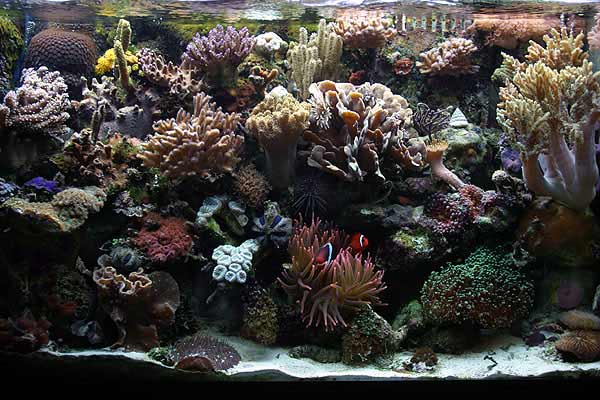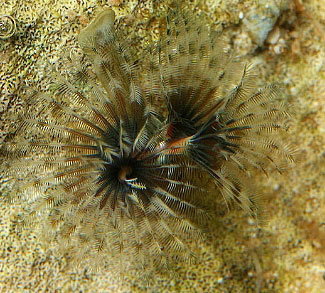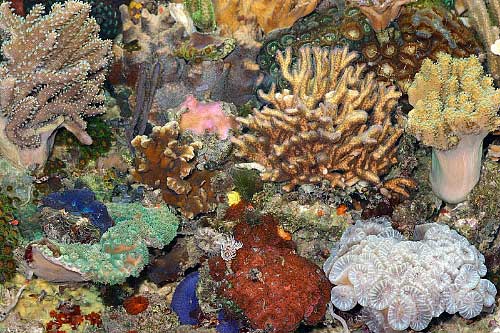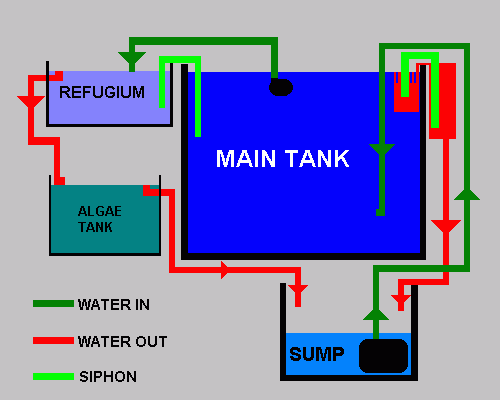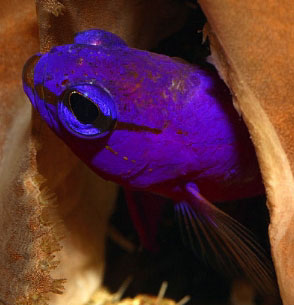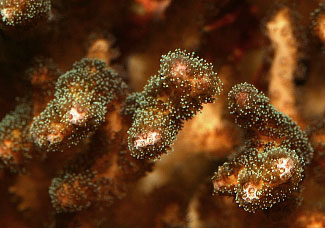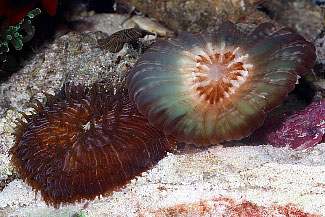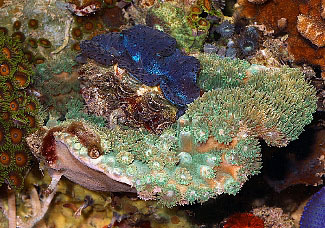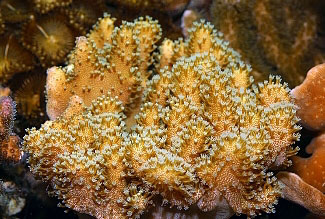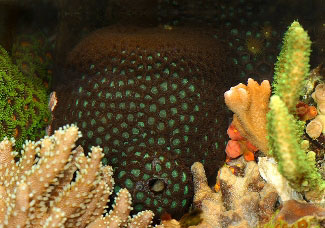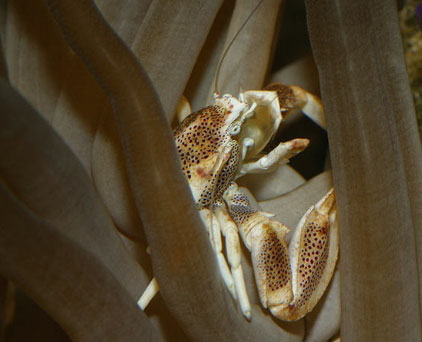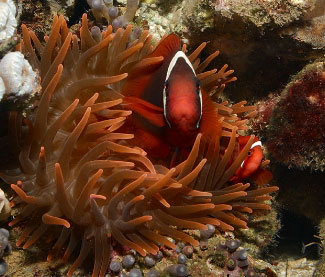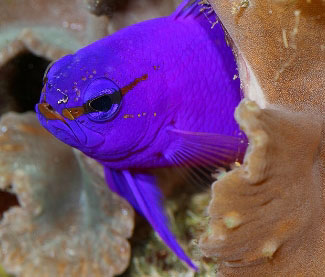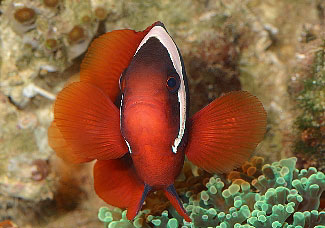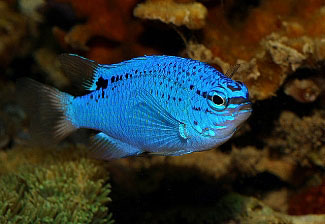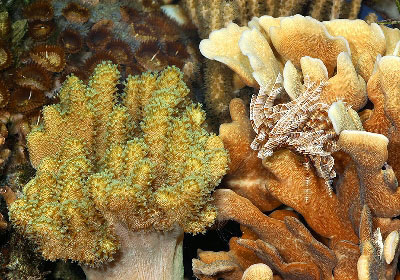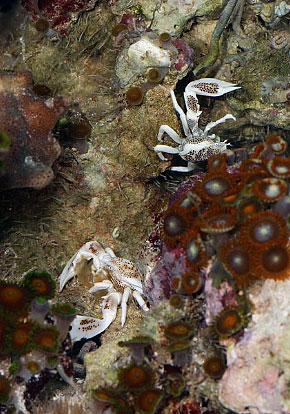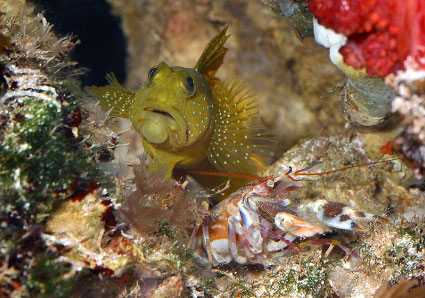
|
|
|
Ken Uy's (Salt Creep) Reef Aquarium
Thanks for featuring my tank! I must admit, after seeing all the awesome tanks featured here before, I didn't think mine would even be considered for tank of the month; after all it's not the great big SPS dominated tanks everybody goes "Ooh" and "Aaah" over. Those who have seen pictures of my tank are often surprised when they get to see it in real life, because the actual size (or lack thereof) isn't apparent in the pictures. The main tank is aquascaped with live rock from various sources and salvaged from my old tank. There are a couple of inches of mixed silica and aragonite sand on the bottom, mostly to give the pistol shrimp something to dig in. Water circulation is provided by two MaxiJet 1000 powerheads controlled by a Sandpoint wavemaker.
Water exits the main tank through an Amiracle hang-on overflow. I wish the tank had a built-in overflow because I have to contend with bubbles occasionally collecting in the siphon tube, but that only happens when too many algae grow in the siphon and overflow box, or if I forget to top off the tank and the water level in the sump drops too much allowing air to be sucked into the return pump and blown into the tank. A Stockman standpipe keeps the overflow from making gurgling noises. A MicroJet pump in the main tank sends water to the propagation tray. The propagation tray is connected to the main tank with a 1 1/4-inch siphon tube, which keeps the water level in the tray at the same height of the main tank. Another MicroJet pump provides extra water circulation in the tray. The tray sits on a wooden stand to raise it to the level of the main tank's upper rim, allowing it to receive lighting from the main tank. It also has a hole drilled in the side with a bulkhead and PVC pipe overflow that drains into the algal tank. The propagation tray gives me a nice place to put coral trimmings to sell or give away, and acts as a refugium of sorts. There is about an inch of live sand in it, plus a large clump of Chaetomorpha, which I trim every week or so.
The algal tank is just a plastic "critter container" minus the lid, with a small bulkhead and PVC overflow on one side, which drains into the sump. It holds an inch or so of sugar fine silica sand and a clump of Caulerpa lentilifera (mini-grape Caulerpa) which I periodically harvest as a method of nutrient export. At one time, I kept dwarf seahorses in this tank, but lost them all to some Aiptasia that were accidentally introduced with a clump of algae. With the seahorses gone, the algae tank is now crawling with "pods" and mysids. There is also a healthy population of small bristleworms living in the algae, which can literally make it a pain to harvest. Water from the tank enters the sump into a chamber formed by a removable acrylic wall to minimize the amount of bubbles getting into the return pump. The water passes through the sides and bottom of the wall into a second chamber, which holds a Turboflotor 1000 protein skimmer. From there, water is sent to the skimmer by a MaxiJet 1000 powerhead. The skimmer's output is directed onto a pile of live rock to reduce the amount of microbubbles that may be sucked into the return pump. The return pump is a Mag Drive 7. The sump also contains a VisiTherm heater set at 78°F.
Lighting: The lights extend beyond the sides of the main tank since the 40 watt bulbs are 48 inches long while the tank is only 30 inches long. This allows me to use the same light source for the propagation tray. I use polished aluminum reflectors on top of the lights. I currently do not have a hood. In fact, the whole setup looks very patched-together, so when I photograph the tank I try not to show the light fixture or the stand (a sturdy old desk with bookshelves leaning on it hides the tangle of power cords underneath). A couple of small fans are used to keep the light fixture cool, and the lights are on at night between 8 p.m. and 6 a.m. when I'm home to enjoy the tank.
Water Parameters: I'm afraid I haven't tested the water for anything since the first few weeks that I set it up. I do get occasional patches of Bryopsis algae, so I imagine the dissolved nutrient levels might be higher than they should be. I do see quite a bit of sponge growth, and small to medium-sized feather duster worms are proliferating, so I feel higher nutrient levels are not such a bad thing.
Inhabitants:
I've had my oldest animals, some zoanthids,
since the mid 1980's. I originally started out with a 15
gallon tank, then changed to a 60 gallon after a couple
of years. The 1994 Northridge earthquake caused a rockslide
that cracked the 60 gallon glass tank. I moved the survivors
to a 60 gallon acrylic tank, but I was never happy with
it (especially after that first scratch!), so I ended up
putting everything in the 29 gallon glass tank. Most of
the additional corals and critters were obtained through
trades with friends and from store credits received from
bringing in Red Sea Xenia frags. Soft corals do very well in this system. SPS corals grow fairly well as long as I start with tank-raised frags and keep them in the upper half of the tank. The SPS corals would probably grow faster if the lights were stronger, but given the amount of space I have left in the tank, I'm not sure I want that. At least not yet! Actually, Pocillopora damicornis seems to do quite well in the tank, and it has even spread around the tank by releasing asexually produced planulae that colonize bare areas such as the overflow box.
Look closely
and you can see that this is a
powerhead overgrown with zoanthids.
In most cases I've just attached the coral frags wherever they fit, and let them grow to fill the space. The corals now grow quite close to each other and I have to prune or reposition them every now and then to keep them from stinging each other.
Symbiotic and commensal relationships
are of particular interest to me. In fact, the main reason
I got into reefkeeping was to watch clownfish playing in
their anemone. I also enjoy observing the paired animals
interact with each other. The Stenopus pair is especially
fun to watch, because the male will collect food and take
it to the female, who then usually confiscates it all. I
haven't seen the clownfish exhibit any real breeding behavior
yet, but the watchman and neon gobies, as well as the shrimp,
apparently spawn on a regular basis.
Feeding & Maintenance: The tank is topped- off daily with about half a gallon of RO filtered water mixed with Mrs. Wage's Pickling Lime (about a tablespoon per gallon) plus around a teaspoon of distilled white vinegar. The water is dripped into the sump from a gallon plastic juice jug through a plastic air valve nozzle with an air hose inserted about a third from the bottom. Theoretically, this allows the lime sediments to settle in the bottom of the jug, but I usually just add the limewater mixture to the sump while it's still milky. Recently, I've started adding some baking soda just in case the alkalinity needs boosting. I feed the tank about twice a day. Usually, I use frozen Mysis shrimp, in the morning when the lights are out, to feed the Tubastrea and the shrimp. When the lights go on in the evening, I feed with Brine Shrimp Direct brine shrimp flakes or Vibragro pellets. The Ricordea mushrooms, the LPS corals, and the anemone are target fed with pieces of shrimp every week or so. Additionally, I sometimes dose with a bit of algae cryopaste when I feel like it. The tank's front glass panel has to be scraped clean every week or so. I also wash the dust and salt deposits off the glass covers and wipe the lights once a week. I try to do a partial water change every month or so but it's not a problem if I skip a few water changes, at least until I start seeing the Bryopsis patches getting bigger. Excess algae are removed once a week. Any corals that are getting too big are also trimmed at this time. The protein skimmer's cup is emptied and cleaned when it gets too full or simply too awful to look at. The siphon tubes for both the overflow and the propagation tray are cleaned whenever they start collecting too many bubbles.
I usually change about five gallons of water every few weeks when I notice a lot of detritus collecting in the sump. I try to judge this by how the corals and fish are looking; if things look a bit "off" or if the algae seem to be growing faster than usual, I make sure the protein skimmer is running properly, then I do a larger water change than usual. The tank system has had its share of problems, ranging from excessive algal growth in the main tank to a massive flatworm infestation in the propagation tray. Oddly enough, the flatworms were never able to establish themselves in the main tank. I've seen the blue damsel and the watchman gobies eating them on the few occasions when my curiosity got the better of me and I actually took some flatworms and put them in the main tank. I suspect this is why they were never able to survive there. The infestation in the propagation tray was cured when I added two Chelidonura varians to eat them. Oddly enough, when I started with a 15-gallon tank I had no trouble keeping anemones, and often had to trade them back to the pet store after they outgrew the tank. I haven't had much success keeping host anemones when I moved on to bigger tanks, and after I started this current tank I only had success with Phymanthus and Condylactis anemones, which made good hosts for anemone shrimp and crabs. Recently, I was able to get a healthy captive propagated rose Entacmaea for my clownfish but, unfortunately, the female clown didn't like sharing the anemone with the crustaceans. The anemone crabs eventually disappeared, presumably eaten by the banded coral shrimp after they lost the protection of their host. On occasion, I've added animals that were unsuited for the tank, like a pair of anemone shrimp that ate most of my Condylactis before I could get them out, and I recently found a sundial snail that was eating my zoanthids. Fortunately, these mistakes were easily remedied. The only other problem with this tank is lack of space. I've lost some frags when they got overgrown by other corals, though I usually manage to rescue them. The Turbinaria colony is now growing against the front glass, and I don't know what to do about that without major rearrangement of the rocks. One of these days I'm moving everything to a bigger tank! This tank has given me a great deal of pleasure over the years. I enjoy growing the corals as if the tank was an indoor garden, and I've met a lot of great people through local aquarium clubs and online message boards like Reef Central. I'm grateful to all the people out there who have shared frags, knowledge, extra equipment, tank-sitting time, car rides, and great conversation with me. You know who you are!
To visit Ken's website click on the image below: A special thanks to Greg Rothschild for all the wonderful photos. Feel free to comment or ask questions about my tank in the forum for the online magazine. |


